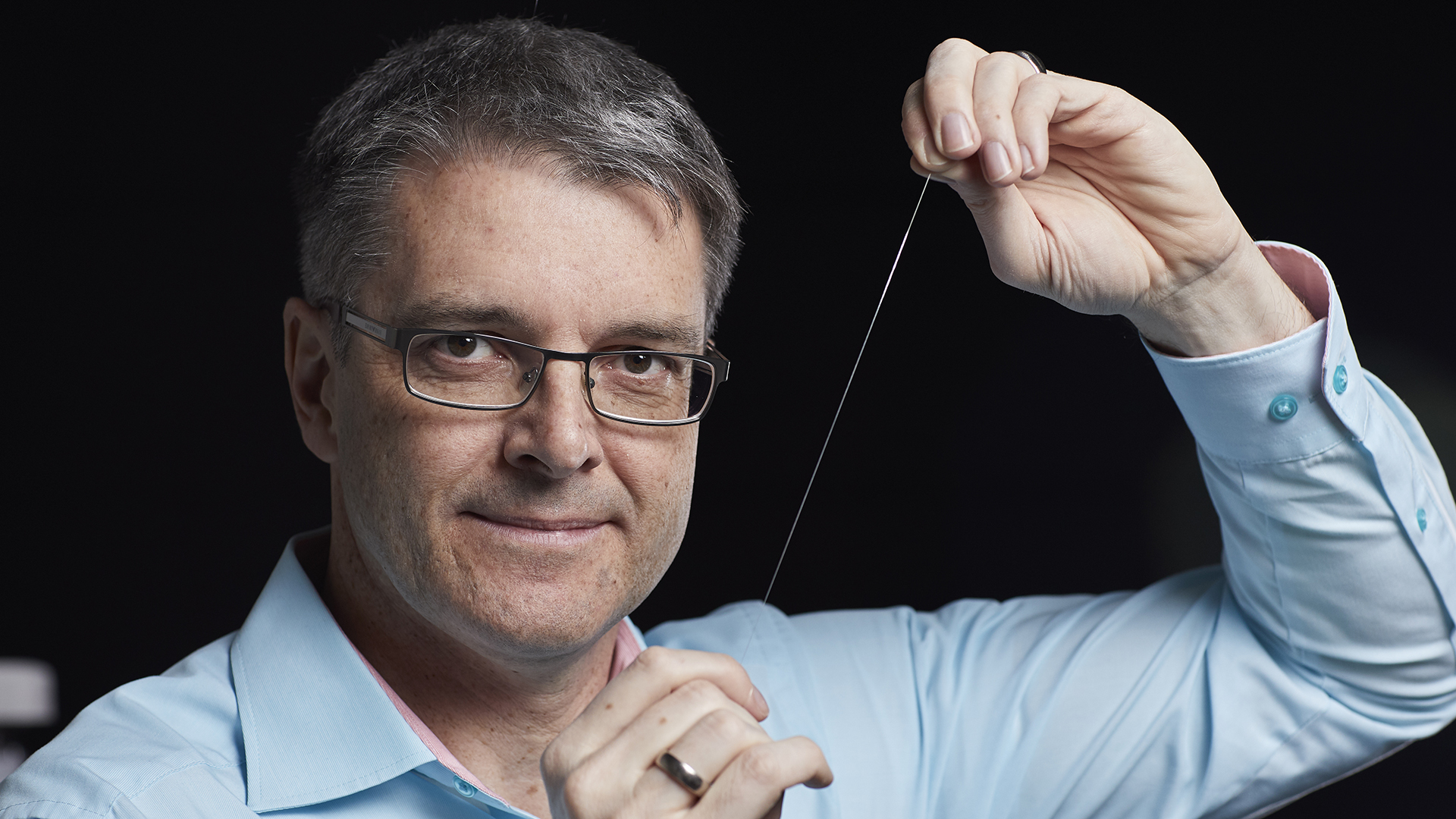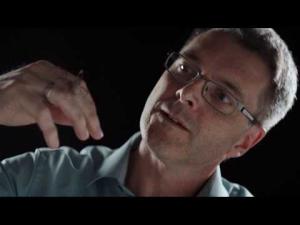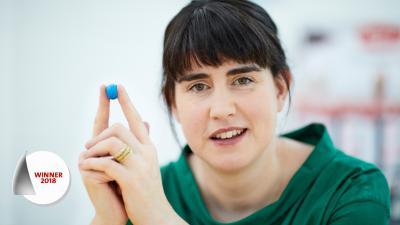Thomas Scheibel
Artificial spider silk
Finalist for the European Inventor Award 2018
Over 300 million years of evolution have produced one of the world's strongest materials – the silk fibres of a spider web. Now, thanks to German biochemist Thomas Scheibel, it is finally possible to mass-produce spider silk as a next-generation industrial fibre. The development of an industrial-scale manufacturing process for bioengineered spider silk, marketed by German start-up AMSilk, unlocks new possibilities in textiles, cosmetics and medicine.
Spider webs are among nature's most resilient structures. Lightweight and almost invisible, they can stretch up to 140 per cent in length without breaking thanks to the incredible strength of spider silk. In fact, spider silk is five times stronger than steel and three times stronger than the Kevlar in bulletproof vests.
Scientists and chemical companies had not been able to mass-produce spider silk. Unlike silkworms, which produce their silk in large quantities, spiders produce only small amounts of their robust thread. Plus, spiders cannot be raised on silk farms due to their cannibalistic and territorial behaviour.
In order to solve the problem, Scheibel decided to take spiders out of the equation: his patented process relies on E. coli bacteria that are genetically reprogrammed to produce spider silk proteins. This raw material is then "spun" into ultra-strength spider silk fibre in a complex mechanical process that took years to perfect.
Brought to market by Munich-based start-up AMSilk in 2014, Scheibel's spider silk is available in industrial quantities, with applications ranging from biotolerable medical implants and lightweight sports shoes to breathable nail polish.
Societal benefit
The invention makes a new "supermaterial" available on a mass scale. Spider silk can withstand pressure of 4.5 gigapascals (GPa), far surpassing bamboo (1 GPa), human teeth (0.5 GPa) and wood (0.3 GPa). Moreover, a strand of spider silk long enough to wrap around the Earth would weigh less than a bar of soap. Biocompatible with a low risk of rejection, it is used to coat medical implants.
Scheibel's process is entirely animal-free. Regular silk is "harvested" from silkworm cocoons. Other approaches to producing spider silk still rely on animals, such as transgenic silkworms that spin cocoons containing spider silk, or genetically engineered goats that produce silk proteins in their milk.
Economic benefit
In order to use his patented process on an industrial scale, in 2008 Scheibel co-founded AMSilk - a spin-off company from the Technical University of Munich (TUM) that is headquartered in Planegg-Martinsried just outside Munich. The majority shareholder is AT Newtec GmbH; the TUM is a minority shareholder. So far the company has raised millions in venture capital, and employs 30 people.
AMSilk sells purified silk protein ingredients in three product lines: first, cosmetic products including breathable Silkgels and controlled-release Silkbead capsules for gels and creams, etc.; second, medical applications such as coatings for medical implants; and finally, a biodegradable performance fibre called Biosteel, which is about 15% lighter than conventional synthetic fibres.
In spring 2017, AMSilk launched a water-based, breathable nail polish, marketed through its licensee Ocean Pharma. A year earlier, Adidas created a concept sports shoe using Biosteel. Spider-silk-coated implants are currently undergoing clinical trials in Europe with Polytech.
Scheibel's synthetic fibres are having an impact on the global market for biopolymers, which generated over EUR 5.6 billion in revenues in 2015, with Europe responsible for 39% of sales - mostly of bioplastic packaging. The invention could also make inroads into the world market for traditional silks, projected to reach almost EUR 14 billion by 2021.
How it works
Recreating the way spiders produce silk in their glands required a process known as "biomimicry" - imitating natural phenomena in the laboratory. To accomplish this, Scheibel pursued a two-step approach.
First, he genetically modified E. coli bacteria by translocating genes from the European garden spider. As a result, the bacteria produced spider silk proteins by fermenting raw materials such as beets and sugar cane.
Mastering this process thus delivered the raw material for spider silk. But the mechanism by which spiders pull strands of silk as fibres for spinning webs proved equally complex to replicate. The fine protein fibre spun by spiders, also called gossamer, contains up to 1 500 strands of spider silk per thread and is processed in so-called spinneret glands.
Ultimately, Scheibel successfully created a mechanical system that replicates the way that spiders "extrude" the thread for spinning their webs - the second step in his approach. Mimicking this process in the laboratory, he solved the last piece of the puzzle to create artificial spider silk.
The inventor
After earning his PhD in Biochemistry from the University of Regensburg in 1998, Thomas Scheibel spent three years doing postdoctoral research at the University of Chicago, where he explored state-of-the-art techniques in molecular genetics. From 2001 onwards, his research as an assistant professor at the TUM focused on technical applications of protein-based materials occurring in nature, including spider silk.
Today, Scheibel holds the Chair for Biomaterials at the University of Bayreuth. A co-organiser of biochemistry symposia such as the German Materials Society Bio-inspired Materials conference, he is listed as the author on seven granted European patents, with other patent applications pending. He has published 112 peer-reviewed articles, 54 review articles and 18 book chapters.
His research and product development efforts have earned him numerous awards, including the Innovation Award from the Bavarian Prime Minister (2006), the Heinz Maier-Leibnitz Medal (2007) and the Max Buchner Research Foundation's DECHEMA Prize (2013). In 2014, he became a member of the German National Academy of Science and Engineering.
Did you know?
Scheibel's invention is not the first at the European Inventor Award in which an organism is tricked into producing proteins that it otherwise would not. In 2006, researchers Zbigniew Janowicz and Cornelius Hollenberg won the European Inventor Award in the "Industry" category for tricking Hansenula yeast into producing proteins for a new hepatitis B vaccine.
AMSilk's ultra-tough fibres are also not the first futuristic materials featured at the European Inventor Award. In 2010, German researchers Jürgen Pfitzer and Helmut Nägele from the Fraunhofer Institute for Chemical Technology were winners in the "SMEs" category for their bioplastic material Arboform, also known as "liquid wood". Other next-generation materials include the steel-wire-reinforced concrete invented by Ann Lambrechts (2011; Industry - winner) and the self-cleaning cement developed by Luigi Cassar, Gian Luca Guerrini and team (2014; Industry - finalists).
Media gallery
Contact
European Inventor Award and Young Inventors Prize queries:
european-inventor@epo.org Subscribe to the European Inventor Award newsletterMedia-related queries:
Contact our Press team#InventorAward #YoungInventors










